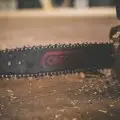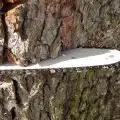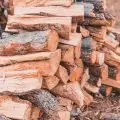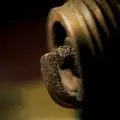This article is for people who want to know how to clean a chainsaw the easy way. Why is cleaning a chainsaw so important? There are many people out there who never even think of cleaning their chainsaws but as you’ll learn in this article, it’s a very good idea to keep your chainsaw clean.
Dirt, dust, and oil can build up and eventually affect the proper functioning of your chainsaw. You should therefore clean your chainsaw on a regular basis, especially if you work in harsh conditions!
Table of Contents
- Why Clean a Chainsaw?
- How to Clean Chainsaw in 7 Simple Steps
- Preparing to Clean the Chainsaw
- Step 1: How to Clean a Chainsaw Bar
- Step 2: How to Clean a Chainsaw Chain
- Step 3: How to Clean the Chainsaw Powerhead
- Step 4: How to Clean the Chainsaw Air Filter (Gas-Powered Only)
- Step 5: Cleaning the Spark Plug (Gas-Powered Only)
- Step 6: Cleaning the Cooling Fins (Gas-Powered Only)
- Step 7: Reassemble the Chainsaw
- FAQs (Frequently Asked Questions)
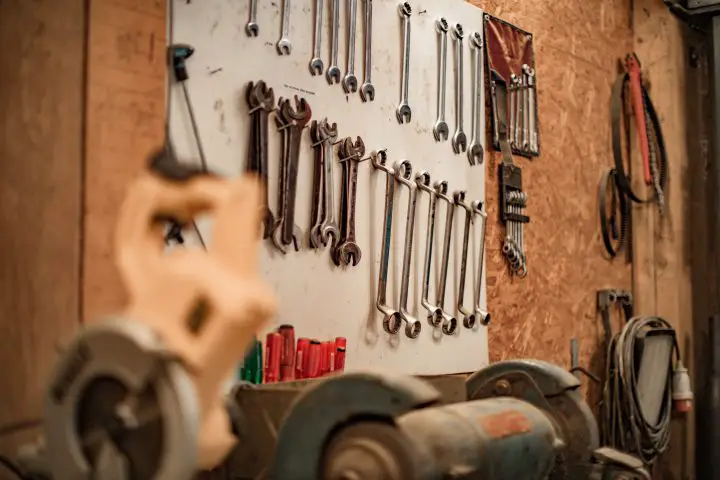
Why Clean a Chainsaw?
Before we start talking about the tools needed and the process of cleaning your chainsaw, let us first explain some of the issues that prevent a dirty chainsaw from running properly and therefore discuss the importance of cleaning a chainsaw.
A chainsaw is an extremely simple machine on the surface, but there is plenty of stuff going on underneath which cannot be seen until you remove the covers and take the whole machine apart.
Whenever a cutting tooth on the saw chain digs into the wood, it will carve out small chips of wood along with tiny powder-like specks of sawdust. The moving chain’s momentum will carry these particles into the groove of the bar upon which the chain is riding.
Some of the sawdust and wood chips may also get flung into the gaps in-between each chain link, thereafter combining with moisture and bar oil to form a semi-solid and highly sticky substance that will soak up any new bar oil being added, preventing it from lubricating the chain. This will not only cause your chain to run hot but also scrape against the bar rails more often which can result in the formation of a burr on either edge of the bar.
Not only is the chain running really hot and causing more friction, but it is also bouncing off this uneven edge of the bar which will result in the chainsaw won’t cut straight and increasing vibrations. A chain that isn’t lubricated will fail a lot sooner than normal, and the last thing you want is sharp metal links flying into your face at 60mph!!
Sap, sawdust, grease, and other contaminants will also accumulate underneath the clutch cover on the side of the chainsaw. These particulates will eventually clog the oiler holes and can harm the performance as well as the reliability of the parts.
More about parts of a chainsaw on the blog.
The inertial brake will slip if too much gunk collects around the chain brake mechanism and you may not be able to stop the chainsaw in the case of emergencies. Sawdust and dirt are also sucked in through the grill underneath the starter rope. This grill sucks in air to cool the engine but it can sometimes suck in debris that is ejected when you cut wood.
An accumulation of sawdust and wooden chips in between the cooling fins on the cylinder head can occur which will restrict airflow and reduce cooling performance. As a result, the engine will run hotter than usual and this may eventually result in damage to the internals of the motor (piston, cylinder, etc.).
On top of all this, the air filter may become clogged, not allowing your chainsaw engine to “breath” properly. When it becomes clogged the carburetor isn’t going to get sufficient air and this will affect engine performance at higher RPMs. If the air filter is extremely dirty, you may not be able to even start the chainsaw at all.
You will also need to properly inspect the spark plug for carbon accumulation, otherwise it may result in incomplete combustion of the fuel/ air mixture and thereafter, a loss of power. A faulty spark plug may also mean that the engine won’t start.
Hopefully, by now, you understand the sheer importance of cleaning your chainsaw!
How to Clean Chainsaw in 7 Simple Steps
Preparing to Clean the Chainsaw
Before you can begin cleaning the various parts of your chainsaw, you must first ensure that there’s no power running to the tool. Otherwise, you could be putting yourself in danger and an accident could occur.
So, before you perform any of the cleaning steps that will be detailed below, make these preparations depending on your type of chainsaw:
- Gas Chainsaws — Drain the fuel tank and disconnect the spark plug connector from the spark plug.
- Battery Chainsaws — Remove the battery.
- Corded Electric Chainsaws — Detach the power cord.
Step 1: How to Clean a Chainsaw Bar
First, you will need to locate the two nuts on the side cover of the chainsaw that mount the guide bar to the powerhead but don’t loosen them just yet. On some particular models of chainsaws, you won’t be able to remove the cover while the chain brake is engaged. While, on other models, you might be able to take the cover off but putting it back on can be an issue. So, always disengage the chain brake before starting this task.
After you have disengaged the chain brake, you can loosen and remove the cover nuts. Then, separate the guide bar and chain from the powerhead and put the chain aside. If the guide bar is moderately dirty, you can simply use soap and water on a rag to clean it. If it’s heavily soiled, then you will likely need a degreaser solvent to loosen this buildup of gunk.
When it comes to cleaning the chainsaw guide bar groove, you can either use a special groove cleaning tool or a putty knife. You should run the tool around the groove until it’s free of any gunk between the rails. Below is an example of one of these groove cleaning tools readily available on Amazon:
- Specs: Description: Bar Groove Cleaner, Cleans groove and oil holes
Prices pulled from the Amazon Product Advertising API on:
Product prices and availability are accurate as of the date/time indicated and are subject to change. Any price and availability information displayed on [relevant Amazon Site(s), as applicable] at the time of purchase will apply to the purchase of this product.
To clean the bar and chain oiler holes that are located at the base of the bar, you can use a toothpick or thin screwdriver to extract any gunk that’s blocking the holes. Using compressed air is also great to blow out these small spots. If your guide bar has a hole near the tip of the blade for oiling the sprocket then you should clean that out too.
Now, you’ve effectively learned how to clean a chainsaw bar!
Step 2: How to Clean a Chainsaw Chain
Make sure you’re in a well-ventilated area before taking a bucket and mixing one cup of ammonia with one gallon of water. You can then place the chainsaw chain in this solution and let it soak for around 15-20 minutes.
It is strongly advised to put on a pair of thick rubber gloves to protect your hand before using a soft-bristled toothbrush to scrub each section of the chain until you have cleaned of all the debris. When the chain is clean, you can rinse it under water to remove the remaining ammonia solution and then immediately dry the chain after so that all of the moisture is removed.
Next, fill a shallow tray halfway with bar and chain oil before submerging the chain in the oil and letting it soak for three hours. After the time has passed you can turn the chain over and let it soak for another three hours. Finally, you can remove the chain from the tray and then use paper towels to dab the chain to get rid of any dripping oil.
Now, you’ve effectively learned how to clean a dirty chainsaw chain! If you haven’t sharpened your chainsaw chain in a while, this is a great time to consider doing it after it has dried.
Step 3: How to Clean the Chainsaw Powerhead
The cleaning of the chainsaw powerhead is quick and simple. First, wipe the exterior of the powerhead body with a dry cloth. Then use a soft paintbrush (typically between 1 to 2 inches wide) to dust off any dirt particulates that have become lodged around the crankcase, clutch drum, and bar studs. If there is any thick gunk that’s stuck in those areas, use a toothpick or thin screwdriver to scrape it out.
If you have an electric chainsaw, whether that be battery or corded, you can skip to step 7 and reassemble the chainsaw as you’re done! However, if you have a gas-powered chainsaw, there are a few more steps involved in the cleaning process.
Step 4: How to Clean the Chainsaw Air Filter (Gas-Powered Only)
To clean the chainsaw air filter you will need to remove the top cover of the chainsaw. Then you will be able to take the air filter out and stuff the air intake with a rag so that no dirt or debris is able to fall into this area. Use that same soft paintbrush (1 to 2 inches wide) to remove any dust that has collected on the air filter.
However, if this doesn’t work because the air filter is excessively dirty, you should run the filter under water to dislodge any particles that are stuck. It’s very important to let it completely dry before reattaching.
Step 5: Cleaning the Spark Plug (Gas-Powered Only)
Now that the top cover is removed, you will be able to access the spark plug. Using a T-Wrench or the supplied Scrench with your chainsaw, unscrew and remove the spark plug. Check to see if the electrodes are a dark brown color, if they are then it should be fine.
If they’re black, chipped, or look damaged in any way, then it’s certainly time for a replacement. Refer to your owner’s manual for the correct spark plug part number or contact your manufacturer directly.
Step 6: Cleaning the Cooling Fins (Gas-Powered Only)
The final cleaning task on the gas-powered chainsaw is to remove the side panel that covers the cooling fins and rope rotor. Then you will be able to use a thin screwdriver to lightly scrape out any gunk that has collected between the cooling fins. You must ensure you’re gentle here as you don’t want to bend or distort the fins.
You can also use the soft paintbrush to remove any collected debris inside the rope rotor area.
Step 7: Reassemble the Chainsaw
Once you have completed all the necessary steps for cleaning your chainsaw, you can reassemble the parts in reverse order so your chainsaw is ready to use!
Now that your chainsaw is clean from the inside out, you should hopefully notice an increase in its performance. However, if your chainsaw is still not operating as effectively as you want, or it’s just way too dirty and gunked up to get spotless, you may want to consider buying a new chainsaw.
There are a lot of good options for new chainsaws these days and it’s worth a look even if you’re not considering the purchase of a new one. Fear not, visit our guide on the best budget chainsaws to find the right one for you!
FAQs (Frequently Asked Questions)
What to clean chain saw with?
Different parts of the chainsaw require different methods. For the guide bar, you can simply use soap and water on a rag to clean it. If it’s heavily soiled, then you will likely need a degreaser solvent. For the chainsaw chain, take a bucket and mix one cup of ammonia with one gallon of water to soak the chain in. For the powerhead, you can use a soft paintbrush (typically between 1 to 2 inches wide) to dust off any dirt particulates that have become lodged around the crankcase, clutch drum, and bar studs.
Can I clean my chainsaw with wd40?
Yes, it’s possible to use WD-40 mixed with warm water in a plastic bucket to remove the grease and rust from the chain. You should soak it for 10 to 15 minutes. Then you can use a soft-bristled toothbrush or wire brush to scrub each section of the chain to remove all the grime. Next, wipe it with a paper towel to remove all dust before rinsing it with water and drying it with a clean rag.
How do I clean the gunk out of my chainsaw?
Depending on where the gunk is, you should be able to use a toothpick or thin screwdriver to extract any gunk that’s blocking your chainsaw. Compressed air is also great to blow out gunk from these small spots.
How often should you clean a chainsaw?
To keep your chainsaw running smoothly it is generally recommended to spend an extra minute or two before and after each use to inspect your chainsaw. Some experts recommend cleaning the chainsaw bar after each use by scraping out any debris inside the track but others will advise that every 20 to 30 hours of use is sufficient.


